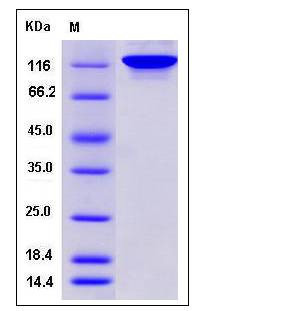Human Autotaxin / ENPP2 / NPP2 Protein (His Tag)
ATX,ATX-X,AUTOTAXIN,LysoPLD,NPP2,PD-IALPHA,PDNP2
- 100ug (NPP3585) Please inquiry
| Catalog Number | P11308-H07H |
|---|---|
| Organism Species | Human |
| Host | Human Cells |
| Synonyms | ATX,ATX-X,AUTOTAXIN,LysoPLD,NPP2,PD-IALPHA,PDNP2 |
| Molecular Weight | The recombinant human ENPP2 consists of 834 amino acids and has a calculated molecular mass of 96 kDa. In SDS-PAGE under reducing conditions, the apparent molecular mass of rhENPP2 is approximately 120-130 kDa due to glycosylation. |
| predicted N | His |
| SDS-PAGE |  |
| Purity | > 88 % as determined by SDS-PAGE |
| Protein Construction | A DNA sequence encoding the mature form of human ENPP2 (AAH34961.1) (Asp 49-Ile 863) was expressed, with a polyhistidine tag at the N-terminus. |
| Bio-activity | |
| Research Area | |
| Formulation | Lyophilized from sterile PBS, pH 7.4 1. Normally 5 % - 8 % trehalose and mannitol are added as protectants before lyophilization. Specific concentrations are included in the hardcopy of COA. |
| Background | ENPP2 (Ectonucleotide pyrophosphatase/phosphodiesterase family member 2), also referred as Autotaxin, is a secreted enzyme encoded by the ENPP2 gene. This gene product stimulates the motility of tumor cells, has angiogenic properties, and its expression is upregulated in several kinds of carcinomas. The Autotaxin protein is important for generating the lipid signaling molecule lysophosphatidic acid (LPA), which is a potent mitogen, which facilitates cell proliferation and migration, neurite retraction, platelet aggregation, smooth muscle contraction, actin stress formation and cytokine and chemokine secretion. ATX has been found to catalyze the formation of cyclic phosphatidic acid (cPA), which have antitumor role by antimitogenic regulation of cell cycle, inhibition of cancer invasion and metastasis. LPA receptors and ATX are upregulated in numerous cancer cell types and show expression patterns that correlate with tumor cell invasiveness. Thus, Autotaxin has recently emerged as an attractive target for the development of anti-cancer chemotherapeutics. In addition, Serum ATX activity was found to be enhanced in relation to hepatic fibrosis in chronic liver disease due to hepatitis virus C infection. |
| Reference |
